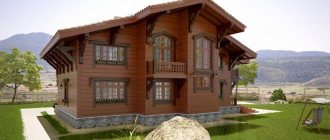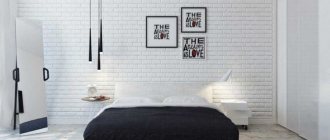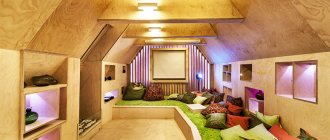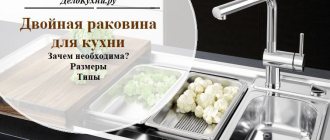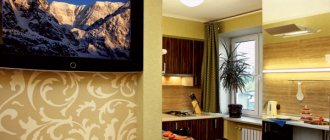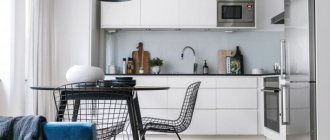Why not look at the world through rose-colored glasses? More precisely, through the multicolor prism of stained glass windows. Stained glass windows in the interior transform the space, make it festive, sophisticated and are perceived as an element of luxury. Stained glass windows, lamps, partitions are sources of incomprehensible magic. Colored reflections scatter across the walls, play on glass surfaces, giving the interior sublimity and uniqueness.
Stained glass kitchen window
History of stained glass
The first stained glass windows were created from small pieces of glass held together by strips of metal, the remains of which were found in Egypt and are over 5,000 years old. The reason for such an intricate technology is explained by the fact that humanity has not yet been able to produce glass of the required area.
In Italy, instead of glass, plates of translucent minerals were inserted into the windows: selenite, alabaster - this protected the rooms from the hot sun and created a mysterious penumbra. Soon they learned to paint glass blue and red, and much later - yellow. Stained glass became an integral part of the architecture of Gothic cathedrals and was subsequently associated for a long time with majestic narrative paintings made of colored glass. The bright rays of the sun broke into myriads of colored fragments, filling the sparse interior of the cathedrals with an unearthly light.
Stained glass door to the spirit
Since then, bursts of fashion for stained glass in the interior have been replaced by oblivion, and new areas of application have been found for them. Stained glass began to decorate not only windows, but also furniture, doors, lamps, remaining an expensive decor for palaces and church cathedrals.
Nowadays there is a surge in interest in stained glass, and it is associated with at least two reasons:
- with a high degree of unification in the construction of buildings and interior decoration;
- with advances in stained glass technology.
Let's consider what traditional and new technologies are used by modern stained glass manufacturers, and what application they find in decorating modern interiors.
Stained glass front door
Materials used
Manufacturers produce various profiles: they can be made of metal, plastic, wood. The most popular are aluminum and plastic options.
Aluminum panoramic windows have the following advantages:
- High strength.
- Small mass.
- Affordable price.
- Can be painted, which significantly expands the range.
- There are also different shapes and sizes, which allows you to choose almost any design, including structures of complex shapes.
- It is quite difficult to hack such a window.
- Aluminum does not rust and can last for a long time.
- Durability.
- Compared to aluminum ones, they are warmer, since the frame has special voids filled with air or gas. There may also be insulation; the glass unit can be double or triple.
- The weight of the structure is greater, so it is not always possible to install it.
- Variety of shapes and colors.
Types of stained glass – from exclusive to democratic
Let's consider three groups of stained glass windows:
- typesetting;
- seamless;
- embossed;
- film
typesetting
In the manufacture of type-setting stained glass windows, two technologies are used:
- Classical
- Tiffany.
Classic typesetting stained glass windows are made of colored glass, cut exactly according to the sketch, connected to each other by an H-shaped lead profile. In modern production, instead of harmful lead, brass, copper, aluminum and cupronickel are used.
Classic typesetting stained glass windows are characterized by rather thick, bright contour lines that correspond to our ideas about stained glass windows from ancient palace or church interiors. Such stained glass windows are traditionally used in windows, but in modern interiors they are used to decorate partitions, lanterns, and wall panels with internal lighting.
Modern stained glass window in minimalist style
The technology of making Tiffany stained glass, invented in the 19th century in America, also belongs to typesetting. In it, the glass is also cut out according to the sketch, but connected to each other differently. Each of the fragments is wrapped around the perimeter with copper foil tape, then the contours are soldered together, and a single stained glass canvas is formed. The creator of the technology, Louis Tiffany, also invented a new way of painting glass in the finest shades. In addition, this technique involves the use of special types of glass, textured surfaces, and the presence of convex and concave elements, which expands expressive possibilities.
The elegant golden outline and new glass coloring technologies allow you to create real works of art. Tiffany stained glass windows illuminated by the sun are an exclusive decor for luxurious interiors. Tiffany technique is used to decorate windows, ceilings, and lamps.
Stained glass above the interior door
Seamless
Seamless technologies include:
- fusing;
- casting;
- etching and sandblasting technology
A completely new technique for creating stained glass - fusing - was invented quite recently, in Germany, in the 90s of the 20th century. Stained glass fragments are not held together by a contour frame, but are sintered at high temperature. Colored parts are laid out on a flat sheet of glass and kept at a temperature until the colored glass softens and fuses with the substrate and adjacent elements.
Stained glass fusing is a fashionable element of the interior; they are distinguished by unique features: the absence of boundaries, smooth color transitions. They are readily used in damp rooms, bathrooms, where stained glass panels are subject to oxidation, and are incredibly effective in window decoration. But fusing technology is especially often used to decorate interior elements - lamps, ceiling lamps, furniture.
Large composition of several windows
Casting is a technology very similar to fusing, but metal contours are used in the production process. They are laid out on a glass substrate, colored glass is placed in the cells, which, after softening, fills the mold and is firmly sintered with it and the substrate. The pattern on stained glass using the casting technique has a contour emphasized by metal, which is also appreciated by interior designers. In addition, the technology makes it possible to make some elements convex.
A special type of stained glass is stained glass made of transparent glass, enhanced by etching. Areas of glass are treated with hydrofluoric acid to create a matte finish. Not everyone knows that in interior design you can use an interesting feature of stained glass using the etching technique - when illuminated from the end, the matte areas glow from the inside.
A safer technology for applying a matte pattern is sandblasting, although in terms of expressiveness and elegance of the design it cannot be compared with etching.
Such stained glass windows are widely used for doors, partitions, windows and any elements of interior decor, including in wet rooms.
Classic stained glass in the bathroom
Embossed
This group includes, first of all, faceted stained glass windows. They are made of thick transparent glass, less often colored glass, using a special cut.
Bevelling is essentially glass carving, chamfering. This is a complex technique that requires a lot of experience from the master. When a bevel is removed along the perimeter of a glass fragment, the sun's rays are refracted in the edges and scattered in a fireworks display of bright highlights. The faceted cells are united by a thin metal frame.
Stained glass windows using the bevel technique are unique due to their special internal glow, the play of light on the edges; in the interior they especially magically transform windows. Faceted stained glass windows are also used to decorate doors, mirrors, and accessories.
Classic stained glass in the kitchen
Film
A very democratic way to create stained glass is film technology. It arose in the 70s of the 20th century. A thin transparent film with a colored pattern is applied to the glass. The self-adhesive lead circuit is secured in the same way.
Film technology has transformed stained glass from an element of luxury into affordable interior decor. Film stained glass gives the glass additional strength - even if it breaks, the film prevents the fragments from scattering. Modern manufacturers recommend this effective, inexpensive technology for self-decorating furniture doors, windows, interior doors, and small decorative details.
Stained glass in retro style
Reasons for choosing stained glass windows
- Buildings designed to include decorative stained glass combinations attract attention no matter what kind of architecture is nearby. Even against the background of the elaborate design of neighboring houses, houses with stained glass windows will not go unnoticed, giving a special artistic appearance to the appearance of the entire building;
- The use of stained glass windows allows you to achieve the effect of “hovering above the ordinary.” Any cottage that has such windows moves from the class of simply an expensive building to the category of exquisite luxury;
- Thanks to the non-standard type of windows with stained glass, the cottage acquires individual beauty, in which the creative fantasies of the owner are realized;
- The emphasis in window designs is on the uniqueness of each manufactured sample, taking into account the individual characteristics and stylistic preferences of the customer, who selects, participates in the development and approval of the sketch of images on the stained glass and the characteristic properties of the designs. You can select a ready-made sample from the catalog. The stained glass product adds uniqueness to the design of the building. It is safe to say that such a house does not exist;
- The capabilities of modern technologies allow the customer to choose a stained glass window of a certain type, style of execution, instruct him to develop a unique version, and even provide the artist with his own sketch for subsequent use in the work.
- The design of the cottage suggests the possibility of adding a spectacular veranda, decorated with entire compositions of multi-colored glass, or a winter garden with fantastic designs on the stained glass. You can develop options that look like colored glass boxes from a distance, providing special refraction of the sun's rays and creating original ensembles. The exclusivity of the design is emphasized with the help of special, thoughtful lighting.
- By decorating the entrance of the home with stained glass elements, the customer demonstrates his exclusivity and high level of respectability. A cottage with stained glass windows emphasizes the excellent taste of the owner and will allow you to earn the image of a true connoisseur of beauty.
Stained glass windows in a modern interior
Stained glass windows can decorate interiors of both classical and modern styles. Exquisite faceted stained glass windows and breathtakingly expensive Tiffany windows, as well as elements made using the etching technique, look organically in classic and baroque styles.
Interiors with antique English or Spanish furniture are nobly complemented by classic stained glass windows. Artistic, airy Art Deco will be enriched with the ringing texture of casting or beveled stained glass windows. Delicate color transitions of fusing glass mosaic and subtle contours of stained glass casting will add a touch of sentimentality to Empire style interiors.
Small stained glass window in the bathroom
An interior in a bohemian boho style or in an ornate oriental style will “accept” stacked stained glass windows using classical techniques and with a modern brass or copper frame profile. A loft, unthinkable without bright elements of luxury, can be effectively decorated with either antique stained glass using classical techniques or film stained glass in the spirit of Andy Warhol’s paintings.
Democratic versions of stained glass using sandblasting or film techniques are common in interiors that follow Scandinavian or Japanese minimalism.
Stained glass on the ceiling with lighting
Personal comfort
Panoramic windows, the dimensions of which are significantly larger than standard ones, are primarily necessary to increase the amount of light entering the room. However, a transparent house is not always convenient because passers-by can easily see everything that is happening inside.
This is not the only problem, since in hot weather the room will become very hot, and in rain or cold it will freeze faster. The sun will start to bother you from early morning if you turn the window to the east. The south side will provide a lot of light, but can cause increased temperatures in the summer. For greater comfort, it is better to turn the panorama to the western or northern side.
A frameless balcony can expand the internal space by 30 centimeters if the structure is made external.
If the balcony glazing is cold, it will not be comfortable to use in winter, so it will not be possible to turn the external structure into additional meters of room.
Accessories that define your mood
Stained glass windows are associated primarily with the high windows of Gothic cathedrals, but what place do they occupy in a modern interior?
Manufacturers have put a lot of effort into developing new stained glass techniques, so varied that it is difficult to name rooms in whose interior stained glass elements could not be used.
Let's look at the most common areas of their application.
The most advantageous technique is stained glass when decorating windows. They look especially impressive in windows facing south. It is precisely when illuminated by the sun and casting mysterious colored reflections that they become a key decorative element of the interior, creating a unique sublime atmosphere.
Photo: stained glass in the bathroom
However, in modern interiors, designers are not limited to established traditions and are finding new areas of application for stained glass. They offer lampshades and ceilings illuminated from within, entirely made using the classic stained glass technique, and partitions using various techniques - sandblasting, classical, fusing.
For partitions and other decorative elements in the bathroom, the fusing technique is ideal, which does not have metal parts and is very durable. Film stained glass windows can be considered a democratic alternative for placement in damp rooms.
Decorative stained glass in the bathroom
In modern interiors, stained glass is often used in an unconventional way - to decorate lamps, mirrors, or act as paintings illuminated from within. Stained glass windows are used to decorate furniture doors – here the leaders are strict ornaments using sandblasting techniques or luxurious exclusive designs applied by etching.
It is advisable that the stained glass motif be repeated three times: in the dominant element, for example, a window or partition, and in one or two smaller ones - a lamp, a painting or a mirror frame.
Stained glass in kitchen cabinets
Positive and negative sides
Stained glass windows in a private house most often have a large width, which can be several times greater than the height. This design is characterized by a high concentration of light indoors. On the outside, it creates a stunning design that attracts the attention of passersby. The advantages of this design:
- Attractive appearance of the facade.
- A bright room with a beautiful view.
- Non-standard solution for the interior.
- High strength, durable design.
- Excellent sound insulation ability.
Manufacturers offer glass reinforced with a special film; thanks to this element, the resistance of the surface against mechanical damage is significantly increased, and heat loss is also reduced in the winter season. To protect against criminals, the moving areas of panoramic windows can be equipped with an alarm.
Any design is not without drawbacks:
- Large windows provide a view not only to you, but also to passers-by who will look into the room. This problem is relevant for residents of the first floors. You can solve this with mirror tinting or large curtains.
- Heat loss in the winter season. Glass, regardless of the thickness of the glass unit, retains heat worse than walls, so heating a room with panoramic glazing will be more difficult. The heating devices themselves cannot be fixed to a glass wall.
- The materials themselves and their installation are quite expensive.
- In summer, the room quickly heats up, furniture upholstery and wallpaper may fade if measures are not taken to protect it from ultraviolet radiation.
How French glazing of a balcony will help to visually expand the space, read our article “Design of a balcony with panoramic glazing.”
And how to arrange a loggia with panoramic glazing, see the link https://oknanagoda.com/steklo/osteklenie-steklo/panoramnoe/13827.html
Magical atmosphere of happiness
Stained glass windows have the ability to transform any room beyond recognition.
Stained glass windows bring a sense of celebration to the living room, emphasizing at the same time its solidity and originality, and in the bedroom they will create a mysterious, intimate atmosphere.
Splashes of colored highlights will fill the children's room with the magic of a good fairy tale. In the bathroom, the light passing through the stained glass partitions and reflecting off the water makes you remember the wonderful weeks spent on the ocean coast.
What about the hallway? It is worth placing curved lamps here, or an illuminated stained glass panel, and, having crossed the threshold of the house, you can safely discard everything routine and everyday and rejoice in meeting loved ones.
Stained glass in the interior
Pattern on a glass door
Calculate the exact cost of repairs using an online calculator
and receive a free detailed estimate for repairs
Calculate
Neat stained glass doors will expand the room and decorate its interior. There will be more light here, despite the opacity of the glass.
Photo:
Photo gallery – stained glass in the interior:
Care methods
Before installing a stained glass structure, you need to weigh the features of its care and think about how to make access to the glass as easy as possible. In high-rise buildings, you most often have to resort to the help of industrial climbers in order to wash the glass, which quickly gets dirty due to its large size.
If the structure is installed in a private house or is located at a height accessible from the ground, then you can use a high folding ladder. It is worth paying attention to the fact that resting it on glass is not recommended. This can ruin the tinting or the surface of the glass itself, which will cause deep scratches.
The windows of private houses usually need to be washed no more than twice a year. In order to reduce the level of pollution, it is necessary to properly organize the drainage system. You can install a special canopy over the window.
Features, advantages and disadvantages
A house with panoramic glazing looks unusual and stylish. And this is exactly what attracts people in such buildings. So a memorable appearance is the first of its advantages.
There are very unusual projects
Where can you see
In private houses, panoramic glazing is installed in living rooms, less often in bedrooms. Sometimes in this way an open veranda is turned into a covered one, sometimes a winter garden is made from the premises. Another possible application is to make one of the walls of the pool glass. In general, there are many applications and they are non-standard and interesting.
Balcony with panoramic glazing - residents of high-rise buildings are provided with an excellent view
In apartment buildings, balconies or loggias are decorated with panoramic windows. It is much less common to find large windows in residential areas in high-rise buildings, but such houses do exist. True, in our country it is extremely rare.
Advantages and disadvantages
If you are thinking that it would be nice to have panoramic glazing in your home, consider the following features:
- The presence of large glass means a lot of light in the room and a beautiful view that opens at any time of the day. That's a plus. But transparency works in both directions: there is also a wonderful view from the street to the room. Especially in the dark, with the lights on. And this is a minus. But it is being adjusted. The standard solution is curtains or blinds, and a non-standard solution is the use of mirrored or tinted glass. But such glass is not cheap, and these are additional costs and, given the considerable area, they are also rather large.
Related article: Electric drives for windows and transoms
Being in everyone's sight - not everyone likes this prospect
Glass requires constant care
In general, there are both advantages and disadvantages of panoramic glazing in the house. When planning to build a house with panoramic windows, take into account such an important factor as the picturesqueness of the landscape overlooking it. If this is a neighbor’s fence, the cost of panoramic glazing is unlikely to be justified...
House with panoramic windows: features
There are also some features that cannot be classified as either advantages or disadvantages. Firstly, glass in panoramic windows can be with or without imposts (beams). Solid glass from floor to ceiling looks stylish, but is expensive, as increased demands are placed on it.
Divided windows look different, but no worse. The cost of such panoramic glazing is lower, but the division into parts by imposts must also be supported by the remaining windows (of normal size). It's worth remembering.
Panoramic windows can be made of solid glass, or from pieces separated by imposts
When planning a site, a house with panoramic windows in our latitudes is recommended to be positioned so that a large glass area faces south with an accuracy of ±30°. In this case, the adjacent room will be light and warm. But there is another disadvantage - the walls, floors, and furniture will fade. One way out is to choose colors where the color loss is not so noticeable. The second way out is to turn the house around so that the panoramic windows face east or west. This is an acceptable position in which there is enough light, and it does not pour into the windows all day long. In general, it's up to you.
The following heating devices are mainly used to heat panoramic windows:
To prevent the cold from coming from the windows in winter, heating devices are placed under them to create a thermal curtain. You cannot install traditional radiators here, but you can install built-in (in-floor) radiators or convectors. They can be electric or part of a water heating system, but their installation is complicated, and their price is considerable.
Projects of houses with panoramic glazing
It’s worth saying right away that the cost of building such a house, at least, will not be cheaper. This impression is due to the large area occupied by the windows. But the windows must be of good quality, and this is not cheap.
Panoramic windows in houses are often made in the bay window. This decorative extension itself gives the house an unusual look, and in combination with large windows, the building acquires individual features.
A house with panoramic windows may have a flat roof. Such buildings are built in modern style, high-tech, minimalism and others with laconic architecture. They have a memorable appearance. They are distinguished by the presence of broken lines, the absence of smooth and rounded ones. And floor-to-ceiling windows only emphasize this feature.
Large windows fit into any home architecture. If the house has any unusual details - roof, porch, etc. — they inexplicably emphasize this detail and the photos of the projects confirm this. If large windows are replaced with ordinary ones, much of the charm of these buildings will be lost.
In combination with sloping roofs of complex shapes, panoramic windows look even more unusual. Such projects are the most spectacular in appearance.
How to make a stained glass window at your dacha with your own hands
We live in a happy time when most of us have country houses - dachas, village houses, luxury mansions, etc. Some people visit there only on summer weekends; some, tired of the bustle of big cities, move to live closer to nature for good; and some don’t even know city life at all. But I am sure that we all love our homes equally and try to decorate them to the best of our ability with carved frames or forging, beautiful curtains and patchwork blankets.
I propose another fairly simple and affordable way of decoration - a stained glass window.
Materials : glass (133*77 cm), black contour paint Gallery Glass 59 ml, 5 contours for glass, 12 tubes of stained glass paints from Plaid, 59 ml each, liquid for imitating glass etching from Plaid, 236 ml.
Originally there was a window above the stairs. It faces east onto a neighbor's property where construction is proposed, so there won't be a picturesque view for several years.
When I decided to make a stained glass window, I decided that I would like to do something in the Art Nouveau style. On the Internet I found a wonderful stained glass window of old St. Petersburg, which was located (I hope to this day) at the address: 7th Krasnoarmeyskaya St., 7.
Having decided on the design, I made a life-size sketch on graph paper. I needed a size of 133-77 cm. Before work, the glass must be thoroughly washed and degreased. I used acetone. To prevent fingerprints from being left and the fat-free layer not to be damaged, in the future I worked in thin latex gloves.
Initially, I wanted to use only Plaid paints, but as for the contours, my patience was only enough for 1 tube of this company. Later it took me 5 black contours for domestic glass


